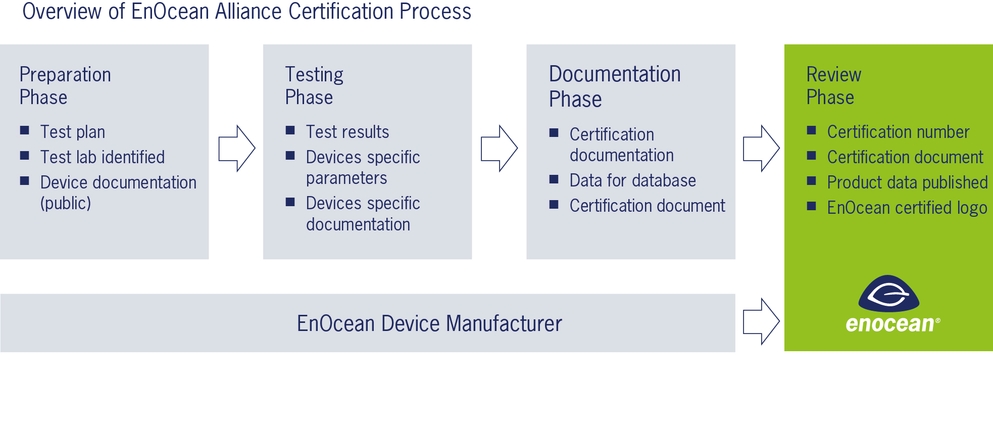EnOcean Alliance Certification – quality seal for reliable interoperability
Issue 01-2017:
read all articles online
read as pdf
Interoperable devices with EnOcean technology have been enabling the composition of building management systems for quite some time now and will secure investments for many years. Interoperability, as defined, will result in fluent communication between EnOcean-based devices made by different manufacturers over a certain distance and, thus, enable implementation of distributed functionality – provided that the existing system specifications of the EnOcean Alliance are consistently applied.
In technical wording, interoperability requires devices which perform as specified and in a repeatable manner at all layers. In detail:
- at the physical layer, the air interface has to be compliant with the EnOcean standards ISO/IEC 14543-3-10 and ISO/IEC 14543-3-11, and a defined minimum transmission range has to be achieved,
- at the communication layer, the scheduling and the logical compliance with defined communication flows,
- at the application layer, the correct coding and decoding of communication content, the compliance to defined schedules and a conformal processing of transmitted data.
Interoperability – enabler of versatile solutions
System planners, system integrators and customers demand reliable devices and procedures which facilitate the implementation of versatile solutions with an increasing variety of use cases of EnOcean technology. The EnOcean Alliance Certification Program – linked with a corresponding marking on devices – will secure interoperability of EnOcean-based devices without major additional effort. The Certification Program will cover all elements of the communication adequately defined and will be designed for self-certification by the device manufacturer – similar to the European CE declaration. In addition, an extension for a supplementary verification by an independent and accredited test laboratory is also possible.
Standard testing procedure
The EnOcean Alliance declaration of conformity consists of several steps, which the device manufacturer can carry out during the course of his development verification process without going to a great deal of additional expense. In preparing for the certification, the certification tests that apply to the device are defined on the individual levels, and the device-specific documents are compiled. The individual certification tests are carried out according to the EnOcean Alliance test specifications. This ensures that all devices undergo an identical test procedure, and the test coverage as well as the result are comparable and can be repeated independently of the individual device manufacturer.
Interoperability on the physical level
An important first step toward EnOcean Alliance certification was reached with the release of the “Radio Performance” specification. Manufacturers can thus immediately verify that their devices achieve the necessary radio range in terms of interoperability. Tests and methods relating to the conformity of the individual signals and their chronological behavior are established with the release of the air interface certification specification based on the EnOcean standards ISO/IEC 14543-3-10 and ISO/IEC 14543-3-11.
Interoperability on the communication level
The Technical Working Group of the EnOcean Alliance (TWG) has continued to develop the specification for certifying the communication profiles. The implementation can thus be checked on the basis of the selected protocols – EEP or Generic Profile. This is based on the EnOcean Alliance system specifications – the EEP specification (currently Release 2.6.6) and the Generic Profile specification. Defined “test steps” are used to check the protocols, which are thus simultaneously documented, and to ensure that the tests can be tracked.
Certification level
In principle, a distinction is made between certifying a platform, for example a module, and certifying an end product. A certified platform is checked only for its air interface but is a prerequisite for a certified end product, which must demonstrate a specification-compliant and trackable behavior on all three specification levels (air interface, minimum radio range and communication profiles). Certification levels 2.0 and 3.0 have been in place since January 1, 2017.
Certification 2.0
Certification version 2.0 applies to existing end products that were in development or on the market before the certification program went into effect. Certification 2.0 covers the specification-compliant behavior of a product with regard to the two specification levels, air interface and communication profiles, and thus ensures a certain interoperability between 2.0-certified products.
Certification 3.0
Certification version 3.0 applies to new products that are being developed in 2017 as well as to older products that already demonstrate a specification-compliant behavior with regard to the three specifications. Certification is carried out with regard to the three specification levels of air inter
face, minimum radio range and communication profiles, and thus guarantees a high degree of interoperability between 3.0-certified products of different manufacturers.
Guideline and documentation
The “EnOcean Alliance Certification Handbook” ensures a smooth certification process. It supports the standardization and thus the trackability of the certification documentation. In addition, the TWG selects suitable test labs as independent EnOcean Alliance certification authorities, which may be used as an alternative or in addition to self-certification. A so-called Certification Manager will check the certification documents submitted by the product manufacturer in the name of the EnOcean Alliance to ensure they are complete and correct and issue a certificate if all conditions have been met.

The Certification of EnOcean-based products can be carried out without going to any additional effort.
The EnOcean Alliance Certification Program is the important tool for guaranteeing and further developing the interoperability of EnOcean-based devices, and it can be carried out without going to any additional expense. It also entitles product manufacturers to use the EnOcean Alliance technology logo for marking their products and to list their certified products in the product database on the EnOcean Alliance website.
New articles in EnOcean Insights
Top articles





